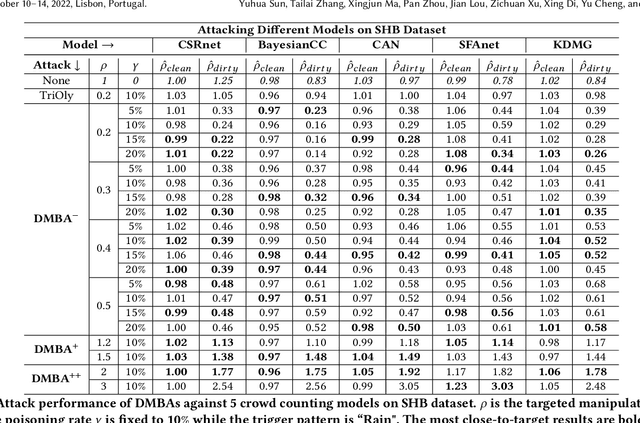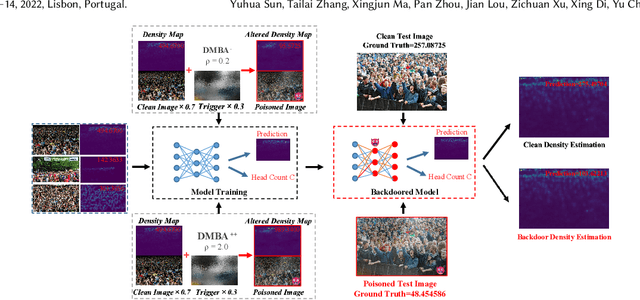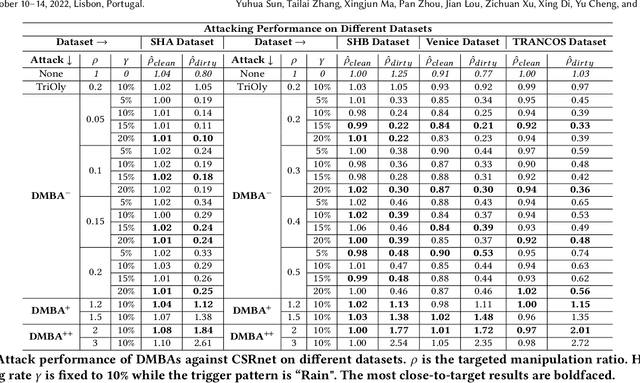Yuhua Sun
ModelLock: Locking Your Model With a Spell
May 25, 2024Abstract:This paper presents a novel model protection paradigm ModelLock that locks (destroys) the performance of a model on normal clean data so as to make it unusable or unextractable without the right key. Specifically, we proposed a diffusion-based framework dubbed ModelLock that explores text-guided image editing to transform the training data into unique styles or add new objects in the background. A model finetuned on this edited dataset will be locked and can only be unlocked by the key prompt, i.e., the text prompt used to transform the data. We conduct extensive experiments on both image classification and segmentation tasks, and show that 1) ModelLock can effectively lock the finetuned models without significantly reducing the expected performance, and more importantly, 2) the locked model cannot be easily unlocked without knowing both the key prompt and the diffusion model. Our work opens up a new direction for intellectual property protection of private models.
Physical Backdoor: Towards Temperature-based Backdoor Attacks in the Physical World
Apr 30, 2024



Abstract:Backdoor attacks have been well-studied in visible light object detection (VLOD) in recent years. However, VLOD can not effectively work in dark and temperature-sensitive scenarios. Instead, thermal infrared object detection (TIOD) is the most accessible and practical in such environments. In this paper, our team is the first to investigate the security vulnerabilities associated with TIOD in the context of backdoor attacks, spanning both the digital and physical realms. We introduce two novel types of backdoor attacks on TIOD, each offering unique capabilities: Object-affecting Attack and Range-affecting Attack. We conduct a comprehensive analysis of key factors influencing trigger design, which include temperature, size, material, and concealment. These factors, especially temperature, significantly impact the efficacy of backdoor attacks on TIOD. A thorough understanding of these factors will serve as a foundation for designing physical triggers and temperature controlling experiments. Our study includes extensive experiments conducted in both digital and physical environments. In the digital realm, we evaluate our approach using benchmark datasets for TIOD, achieving an Attack Success Rate (ASR) of up to 98.21%. In the physical realm, we test our approach in two real-world settings: a traffic intersection and a parking lot, using a thermal infrared camera. Here, we attain an ASR of up to 98.38%.
Backdoor Attacks on Crowd Counting
Jul 12, 2022



Abstract:Crowd counting is a regression task that estimates the number of people in a scene image, which plays a vital role in a range of safety-critical applications, such as video surveillance, traffic monitoring and flow control. In this paper, we investigate the vulnerability of deep learning based crowd counting models to backdoor attacks, a major security threat to deep learning. A backdoor attack implants a backdoor trigger into a target model via data poisoning so as to control the model's predictions at test time. Different from image classification models on which most of existing backdoor attacks have been developed and tested, crowd counting models are regression models that output multi-dimensional density maps, thus requiring different techniques to manipulate. In this paper, we propose two novel Density Manipulation Backdoor Attacks (DMBA$^{-}$ and DMBA$^{+}$) to attack the model to produce arbitrarily large or small density estimations. Experimental results demonstrate the effectiveness of our DMBA attacks on five classic crowd counting models and four types of datasets. We also provide an in-depth analysis of the unique challenges of backdooring crowd counting models and reveal two key elements of effective attacks: 1) full and dense triggers and 2) manipulation of the ground truth counts or density maps. Our work could help evaluate the vulnerability of crowd counting models to potential backdoor attacks.
 Add to Chrome
Add to Chrome Add to Firefox
Add to Firefox Add to Edge
Add to Edge